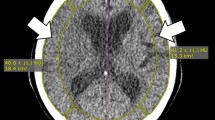Abstract
Objectives
To evaluate a new approach for reconstructing angiographic images by application of wavelet transforms on CT perfusion data.
Methods
Fifteen consecutive patients with suspected stroke were examined with a multi-detector CT acquiring 32 dynamic phases (∆t = 1.5s) of 99 slices (total slab thickness 99mm) at 80kV/200mAs. Thirty-five mL of iomeprol-350 was injected (flow rate = 4.5mL/s). Angiographic datasets were calculated after initial rigid-body motion correction using (a) temporally filtered maximum intensity projections (tMIP) and (b) the wavelet transform (Paul wavelet, order 1) of each voxel time course. The maximum of the wavelet-power-spectrum was defined as the angiographic signal intensity. The contrast-to-noise ratio (CNR) of 18 different vessel segments was quantified and two blinded readers rated the images qualitatively using 5pt Likert scales.
Results
The CNR for the wavelet angiography (501.8 ± 433.0) was significantly higher than for the tMIP approach (55.7 ± 29.7, Wilcoxon test p < 0.00001). Image quality was rated to be significantly higher (p < 0.001) for the wavelet angiography with median scores of 4/4 (reader 1/reader 2) than the tMIP (scores of 3/3).
Conclusions
The proposed calculation approach for angiography data using temporal wavelet transforms of intracranial CT perfusion datasets provides higher vascular contrast and intrinsic removal of non-enhancing structures such as bone.
Key points
• Angiographic images calculated with the proposed wavelet-based approach show significantly improved contrast-to-noise ratio.
• CT perfusion-based wavelet angiography is an alternative method for vessel visualization.
• Provides intrinsic removal of non-enhancing structures such as bone.






Similar content being viewed by others
References
Morhard D, Wirth CD, Fesl G et al (2010) Advantages of extended brain perfusion computed tomography: 9.6 cm coverage with time resolved computed tomography-angiography in comparison to standard stroke-computed tomography. Invest Radiol 45:363–369
Thierfelder KM, Sommer WH, Baumann AB et al (2013) Whole-brain CT perfusion: reliability and reproducibility of volumetric perfusion deficit assessment in patients with acute ischemic stroke. Neuroradiology 55:827–835
Thierfelder KM, von Baumgarten L, Löchelt AC et al (2014) Diagnostic accuracy of whole-brain computed tomographic perfusion imaging in small-volume infarctions. Invest Radiol 49:236–242
Smit EJ, Vonken E, van der Schaaf IC et al (2012) Timing-invariant reconstruction for deriving high-quality CT angiographic data from cerebral CT perfusion data. Radiology 263:216–225
Smit EJ, Vonken E, van Seeters T et al (2013) Timing-invariant imaging of collateral vessels in acute ischemic stroke. Stroke 44:2194–2199
Liebeskind DS (2003) Collateral circulation. Stroke 34:2279–2284
McVerry F, Liebeskind DS, Muir KW (2012) Systematic review of methods for assessing leptomeningeal collateral flow. AJNR Am J Neuroradiol 33:576–582
Saarinen JT, Rusanen H, Sillanpää N (2014) Collateral score complements clot location in predicting the outcome of intravenous thrombolysis. AJNR Am J Neuroradiol 35:1892–1896
Bae KT (2010) Intravenous contrast medium administration and scan timing at CT: considerations and approaches. Radiology 256:32–61
Calleja AI, Cortijo E, García-Bermejo P et al (2013) Collateral circulation on perfusion-computed tomography-source images predicts the response to stroke intravenous thrombolysis. Eur J Neurol 20:795–802
Tan JC, Dillon WP, Liu S et al (2007) Systematic comparison of perfusion-CT and CT-angiography in acute stroke patients. Ann Neurol 61:533–543
Sourbron S, Biffar AF, Ingrisch M et al (2009) PMI0.4: platform for research in medical imaging. Proc. ESMRMB, Antalya
Klein S, Staring M, Murphy K et al (2010) elastix: a toolbox for intensity-based medical image registration. IEEE Trans Med Imaging 29:196–205
Beier J, Büge T, Stroszczynski C et al (1998) 2D and 3D parameter images for the analysis of contrast medium distribution in dynamic CT and MRI. Radiologe 38:832–840
Morlet J, Arens G, Fourgeau E, Glard D (1982) Wave propagation and sampling theory—Part I: complex signal and scattering in multilayered media. Geophysics 47:203–221
Grossmann A, Morlet J (1984) Decomposition of Hardy functions into square integrable wavelets of constant shape. SIAM J Math Anal 15:723–736
Daubechies I (1990) The wavelet transform, time-frequency localization and signal analysis. IEEE Trans Inf Theory 36:961–1005
Farge M (1992) Wavelet transforms and their applications to turbulence. Annu Rev Fluid Mech 24:395–457
Torrence C, Compo GP (1998) A practical guide to wavelet analysis. Bull Am Meteorol Soc 79:61–78
Boas FE, Fleischmann D (2012) CT artifacts: causes and reduction techniques. Imaging Med 4:229–240
Landis JR, Koch GG (1977) The measurement of observer agreement for categorical data. Biometrics 33:159–174
Acknowledgements
The scientific guarantor of this publication is Olaf Dietrich. The authors of this manuscript declare no relationships with any companies, whose products or services may be related to the subject matter of the article. The authors state that this work has not received any funding. No complex statistical methods were necessary for this paper. Institutional Review Board approval was obtained. Written informed consent was waived by the Institutional Review Board. Methodology: retrospective, experimental, performed at one institution.
Author information
Authors and Affiliations
Corresponding author
Rights and permissions
About this article
Cite this article
Havla, L., Thierfelder, K.M., Beyer, S.E. et al. Wavelet-based calculation of cerebral angiographic data from time-resolved CT perfusion acquisitions. Eur Radiol 25, 2354–2361 (2015). https://doi.org/10.1007/s00330-015-3651-1
Received:
Revised:
Accepted:
Published:
Issue Date:
DOI: https://doi.org/10.1007/s00330-015-3651-1




